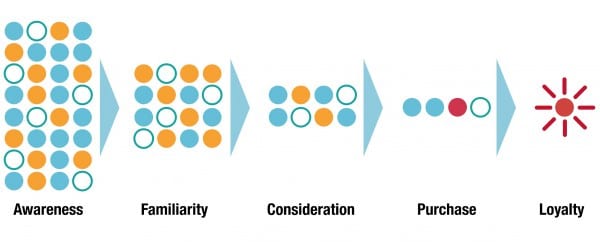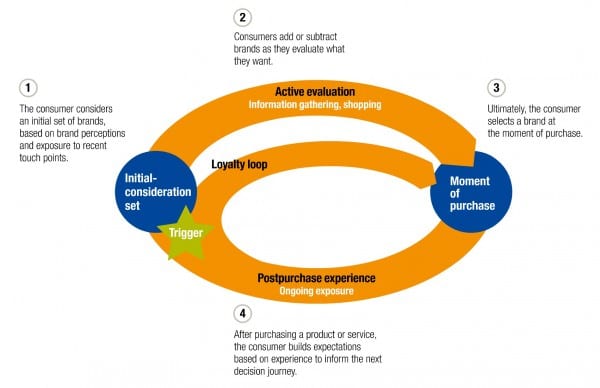Digital creates new battlegrounds where brands can win (or lose)
Dave and I were reminded of this 2009 McKinsey model recently since it raises useful questions about modern marketing which marketing managers need to answer when creating plans to get the best results. In 2012 Google's Zero Moment of Truth (ZMOT) which paints a similar picture of changing consumer behaviour is also gaining a lot of interest. Originally published in 2011, it's worth downloading the latest free 2012 PDF handbook .
Both new models show that funnel models of purchase are becoming less useful (if they ever were) and we need to use new models to plan effectively. We thought it best to summarise both models in a two-part format under the umbrella of 'customer purchase journeys'. So here, in Part 1 I review the relevance of the McKinsey consumer purchase journey.
A question originally asked by Procter & Gamble
It's important to credit Procter & Gamble first and foremost. In 2005 Procter & Gamble introduced marketers to the ‘First Moment of Truth’, what they understood to be the critical instant when a shopper stands in front of the shelf and makes a purchasing decision. P&G realised that everything hangs on that moment and so reverse-engineered their campaigns from the store shelf back, focusing on winning when it matters most. Of course 'first' implies there is at least two moments, which there is, handily named The Second Moment of Truth. Of course, this follows purchase, it's the experience that the consumer, or anyone else in that house-hold, has whilst using the product for the first time, they have an experience which may drive loyalty and in turn advocacy. Both McKinsey's Consumer decision journey and Google ZMOT are making suggestions around what this means for marketers who aren't necessarily in-store, though are online.
McKinsey's consumer decision journey
In 2009 the McKinsey authors, having interviewed 20,000 people in the three major markets (US, Germany, Japan), suggested that the purchase funnel as we know it, is dead. Not a little different, but totally wrong.
"If your marketing hasn’t changed in response, it should." McKinsey & Company
A different world
If marketing has one goal it's to reach its consumers at the moments that most influence decision? Of course, the McKinsey report is suggesting that those moments are what's changed. That an empowered consumer is adept at researching online, asking their peers and friends for purchase advice, searching for independent and expert reviews. McKinsey believe that it's this underlying change in behaviour which is leaving marketing with a potentially very dated model in the drive for success.

McKinsey suggest that the marketing funnel concept fails to capture all of the touch points and buying factors resulting from the explosion of product choices and digital channels, coupled with an increasingly well-informed consumer. A more sophisticated approach to marketing is now required to help marketers navigate this new environment, which is no longer linear and so more complicated than a traditional sales and marketing funnel might suggest. McKinsey call this approach the consumer decision journey.

What's really changed?
McKinsey say that the traditional funnel does help by providing a way to understand the strength of a brand compared with its competitors at different stages, whilst making it possible to focus on different aspects of the marketing challenge. McKinsey suggests that consumers systematically narrowing the initial-consideration set as they weigh options, make decisions, and buy products is not true anymore. Marketers have been taught to “push” marketing toward consumers at each stage of the funnel process to influence their behaviour, so what's changed?
- Noise: The proliferation of media and products requires marketers to find new ways to get their brands included in the initial-consideration set that consumers develop as they begin their decision journey. Advertising or sales promotion alone cannot cut-through.
- Two-way: A shift away from one-way communication — from marketers to consumers — toward a two-way conversation, requires that marketers have a more systematic way to satisfy customer demands and manage word-of-mouth.
- Alignment: Aligning all elements of marketing (strategy, spend, channels, and message) with the journey that a consumer undertakes when they make purchasing decisions. The moments of maximum influence.
- Loyalty: The research identifies two different types of loyalty, this challenges companies to reinvent their retention or loyalty programmes and the way they manage the customer experience post purchase.
Is it just semantics, the funnel always looped?
Personally I'd suggest that the funnel process has always been circular due to customer word-of-mouth, referral and loyalty, and logically there will always be less volume at different stages or touch-points. A thrilled or irritated consumer always told fellow consumers about their experience, used their experience to inform future decisions, the difference is now they can take to social media or brand/retailer websites to share, review or comment, as well.
Another layer in the funnel, or 'social' at every stage?
We know that consumers have progressively migrated to trusting friends and family more than institutions and brands. That peer-to-peer influence, fuelled by social media, is largely the driver of what we currently call social media marketing, or word-of-mouth marketing, or even content and inbound marketing (choose your jargon). I'll call it social media for simplicity.
Appreciating that the customer is in a tribe (to coin a Seth Godin term) matters too, something that McKinsey reference but don't see through. Those tribes have similar values and goals, recognising that they exist in your market and the potential influencers within them and presenting useful, genuine, differentiated and engaging content, is the opportunity. Yet that should happen at every stage of a funnel or a circle, even more so at the first touch-points? We think so, and posted this content marketing info-graphic some time ago.
Drawing consumers into the process matters but will not guarantee their loyalty, that's for the brands to deliver on the experience at every touch-point including the product and service itself, loyalty is never going to be assured.
What to do?
Most marketers will not have the resources of McKinsey clients, let's be realistic! Equally you may be able to continue growing your marketing effectiveness doing exactly what you're doing. But, let's recognise the fundamental shift that has gone on around us and what McKinsey are reporting too. There is a new reality for marketing: that consumers are continuously evaluating brands, and our brands need to be present and accounted for at every stage of consideration. So what can you do, fortunately David Edelman of McKinsey more recently (2011) offered for actions, summarised here:
- Align – Marketers will need to align their resources with “where consumers spend their time.” The “evaluate” and “advocate” stages will likely become more significant to consumers than the “consider” and “buy” stages, and marketers will have to respond accordingly. Edelman suggests that this likely requires moving spend not only from paid media to social channels, but considering if the 80% of your spend allocated to "pre purchase" promotion makes sense?
- Link – Marketers need to ensure that every message about a product or service is consistent across every touch-point or channel. With so many different online and offline outlets, maintaining that consistency will be harder than ever.
- Lock – Marketers must “lock in” (I'd suggest "earn" is the reality here) a customer’s attention by providing direct, opt-in channels, such as email promotions, Facebook and Twitter feeds, and apps that truly benefit the customer. This means allocating resources to content that engages the customer at every stage of their journey.
- Loop – Funnel or circle, it's a loop! Marketers must accommodate that process with a continuous loop that mines data, uses it to create valuable, relevant content, and then analyses consumer response. Edelman uses Amazon as a classic example: The customers can rate products, which it shares with other customers; Amazon then analyses and uses that information to create personalised recommendations.
What we might do is what matters most, and it's on this note that we'll describe ZMOT, part 2, next week where Google has made practical recommendations to market in a changing customer environment.
Here's the full McKinsey report:









